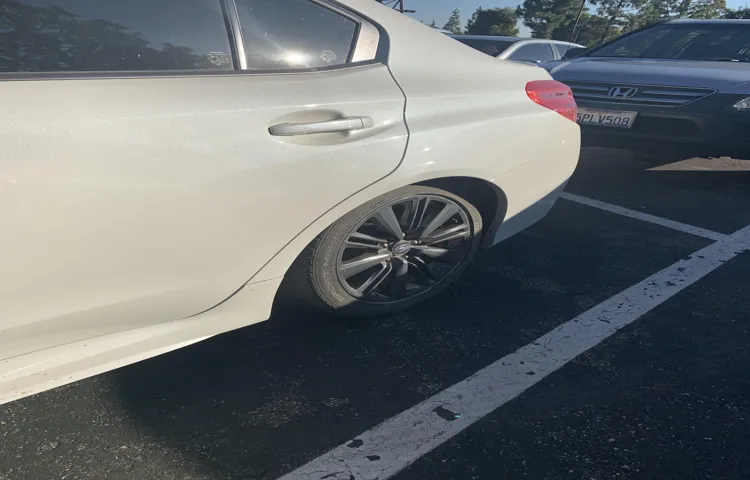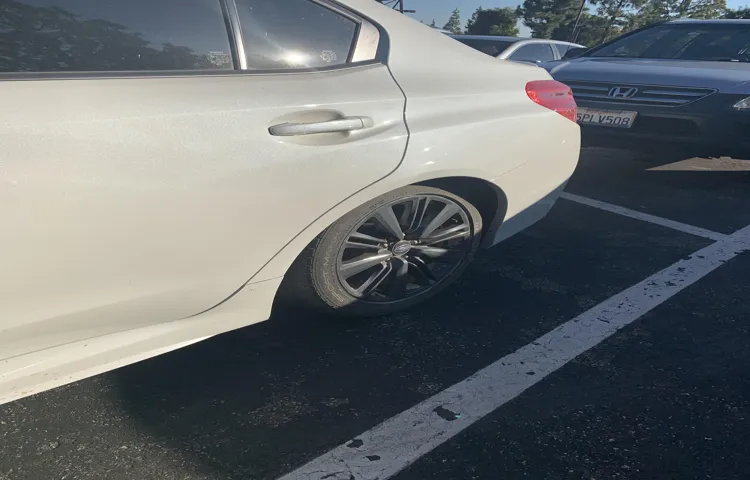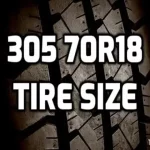Have you ever noticed that one of your tires is slanted inwards, causing it to wear out more quickly and affecting the handling of your vehicle? This can occur for a variety of reasons, but often it is due to misalignment or worn-out suspension components. When your tires are not aligned properly, they can put uneven pressure on different parts of the tire, causing it to wear down on one side faster than the other. This can lead to a variety of problems such as poor handling, reduced fuel efficiency, and an increased risk of accidents.
In this blog post, we’ll explore why your tire may be slanted inwards and how you can fix the problem. So buckle up and let’s dive in!
Table of Contents
Possible Causes of Inward Slanting Tires:
“Why is my tire slanted inwards?” is a question that many drivers ask themselves. One possible cause of inward slanting tires is worn-out suspension components, such as ball joints, tie rod ends, or wheel bearings. These parts help maintain the correct wheel alignment and support the weight of the car.
If they’re worn and loose, the wheels can tilt inward, causing uneven tire wear, steering problems, and reduced stability on the road. Another common reason for inward-leaning tires is uneven tire pressure. If one or more tires are underinflated, the car may sag on one side, causing the wheels to tilt inward.
You should check your tire pressure regularly and adjust it according to the manufacturer’s recommendations. Finally, hitting a curb or pothole can cause your wheels to go out of alignment and tilt inward as well. In any case, if you notice your tire slanting inwards, you should have a mechanic inspect your suspension and alignment to prevent further damage to your car and ensure your safety on the road.
1. Worn out Ball Joints
Possible Causes of Inward Slanting Tires are often linked to worn-out ball joints. Ball joints connect the suspension system to the steering knuckles and allow for smooth up-and-down movement of the wheels. As ball joints wear down, they can cause the wheels to become misaligned, leading to inward slanting tires.
This misalignment can put additional strain on other parts of the suspension system, leading to further damage. Apart from inward slanting tires, other symptoms of worn-out ball joints include clunking noises, uneven tire wear, and a loose or wandering steering wheel. Regular inspections and maintenance of your vehicle’s suspension system can help prevent these issues and prolong the life of your tires.
If you notice any unusual symptoms, it is essential to get your car checked by a trusted mechanic to assess any potential damage. Don’t let worn-out ball joints cause further damage to your suspension system, which can result in safety concerns on the road.

2. Misaligned Wheels
When your tires start to slant inward, it can be a sign that your wheels are misaligned. Several factors can cause your wheels to get out of alignment, including hitting a pothole or bump in the road, driving on rough terrain, or even just normal wear and tear on your vehicle. It’s important to address misaligned wheels promptly, as they can put undue stress on your tires and lead to uneven wear patterns.
Getting regular wheel alignments can help prolong the life of your tires and keep your vehicle running smoothly. If you notice your tires slanting inward, it’s best to have a professional take a look to diagnose and fix the problem as soon as possible. So, it’s essential to have a routine check-up of your vehicle to avoid tire misalignment.
3. Failed Wheel Bearings
Possible Causes of Inward Slanting Tires Inward slanting tires can be a frustrating and potentially dangerous issue, but what causes it? There are several possible culprits, so it’s important to get your vehicle checked by a trusted mechanic to determine the root cause. One possible cause of inward slanting tires is failed wheel bearings. Wheel bearings are responsible for allowing the wheels to spin smoothly and evenly, and when they fail, they can cause the wheel to wobble or become loose.
This can lead to uneven tire wear and ultimately cause the tire to slant inward. If you’re experiencing this issue, don’t delay in getting your vehicle checked out to ensure your safety on the road.
Effects of Inward Slanting Tires:
“Why is my tire slanted inwards?” This is a common question that many car owners ask themselves when they notice that their tires are not level with the ground. The inward slant of a tire is referred to as negative camber, and it can affect your car’s handling and safety. Negative camber is often caused by worn suspension components or an alignment issue, but it can also be a result of intentional modifications made to enhance performance.
While some drivers may prefer a lower camber angle for improved grip during turns, excessive negative camber can lead to uneven tire wear, reduced braking performance, and potential loss of control on wet or slippery roads. If you’ve noticed an inward slanting tire on your vehicle, it’s important to have it inspected by a qualified mechanic to determine the cause and prevent any potential safety hazards.
1. Uneven Tire Wear
Uneven tire wear is a common issue faced by car owners. If you notice that your tires are wearing out on the inside more than the outside, it could be a result of inward slanting tires. The effects of inward slanting tires are significant and can lead to safety concerns.
One effect is reduced vehicle stability and handling, as inward slanting tires can cause your vehicle to pull in one direction, especially during cornering or sudden maneuvers. This can be dangerous as it can lead to loss of control and accidents. Furthermore, inward slanting tires can also lead to increased fuel consumption, as more energy is required to move the vehicle forward due to the added resistance of the tires rubbing against the road.
To prevent uneven tire wear and the negative effects of inward slanting tires, it is essential to regularly check your tire alignment and have it adjusted by a professional if necessary.
2. Reduced Vehicle Stability
When tires are inwardly slanted, it can have a significant impact on the stability of a vehicle. This is especially true during high-speed turns or when driving on wet or slippery surfaces. Inward slanting tires can cause the vehicle to have reduced grip and traction, leading to a higher risk of skidding or spinning out of control.
Additionally, the slanting tires can cause the vehicle to sway or wobble, compromising its overall stability. This is particularly concerning for large vehicles, such as trucks and SUVs, which can be more difficult to handle in the event of a loss of control. As a driver, it’s important to check your tires regularly and ensure that they are properly aligned and balanced.
This can help to reduce the risk of accidents caused by inwardly slanting tires and improve the overall safety and stability of your vehicle on the road.
How to Fix Inward Slanting Tires:
Have you ever wondered why your tire is slanted inward? Inward slanting tires are often caused by a misalignment in the suspension system. When your suspension is out of alignment, one side of the tire will be tilted inward, causing it to wear out unevenly. This can lead to decreased stability and decreased fuel efficiency.
One way to fix this issue is by having a professional mechanic align your suspension. They will adjust the camber, caster, and toe angle to ensure that your tires are properly aligned. Additionally, regular tire rotations and inflation checks can help prevent uneven wear and prolong the life of your tires.
It’s important to address inward slanting tires as soon as possible to ensure a safe and comfortable driving experience.
1. Get a Professional Alignment
If you have noticed that your tires are slanting inwards, then there is a good chance that your vehicle needs a professional alignment. This misalignment can lead to uneven wear on your tires, decreased fuel efficiency, and even affect your handling and safety on the road. A professional alignment will adjust your suspension and steering system to ensure that your tires are properly aligned with the road and each other.
This will not only fix your inward slanting tires but also improve your overall driving experience. Don’t ignore this issue as it can lead to more serious problems down the road. Take your vehicle to a trusted mechanic and get a professional alignment done to keep your tires and your car in top shape.
2. Replace Failed Components
If you’re dealing with inward slanting tires, the first thing to check is your alignment. If that’s not the issue, it’s likely that you have some failed components that need to be replaced. One of the most common culprits is the strut assembly, which helps to absorb shocks and impacts while you’re driving.
Over time, these can wear down and cause your tires to tilt inward. Another component that may need replacing is the control arm, which helps to keep your wheels in line with your car’s body. If this part is damaged or worn, you’ll likely experience some serious steering issues, and your tires may start to wear unevenly.
To fix inward slanting tires, you’ll want to take your car to a trusted mechanic who can diagnose the problem and get your car back in working order.
3. Regular Maintenance
Regular maintenance is crucial to keep your vehicle running smoothly and safely on the road. One common issue that can arise is inward slanting tires. This can occur due to several reasons, such as improper alignment, worn-out suspension components, or incorrect tire inflation.
If you notice inward slanting tires, it’s best to have your vehicle inspected by a professional mechanic. They can diagnose the underlying issue and recommend the appropriate repairs. Neglecting the issue can lead to uneven tire wear, poor handling, and reduced fuel efficiency.
By staying on top of regular maintenance tasks, such as tire rotations and alignments, you can prevent inward slanting tires and ensure your vehicle is performing at its best on the road.
Conclusion
Well, the answer to your tire slanting inward may not be as straight-forward as you’d like. It could be due to a number of factors, such as improper alignment, worn-out suspension, or even an overzealous parallel parking job. So, really, the slant could be seen as a symbol of the complexities of life – sometimes things just don’t go as expected, and it’s up to us to figure out the root cause and fix it.
But fear not, with a little bit of investigation and perhaps some assistance from a trusted mechanic, your tire will be back on the straight and narrow in no time. Remember, life may be full of twists and turns, but your tire alignment doesn’t have to be.”
FAQs
What can cause my tire to slant inwards?
Tire misalignment, damaged suspension parts, or worn out bushings can cause your tire to slant inwards.
Can driving with a slanted tire cause any problems?
Yes, driving with a slanted tire can cause uneven wear on the tire, decrease fuel efficiency, reduce handling, and possibly affect the overall safety of your vehicle.
How can I tell if my tire is slanted inwards?
Look for uneven tire wear, a pulling sensation when driving, or a visual gap between the tire and the vehicle body. If you suspect a problem, take your car to a mechanic for an inspection.
Can I fix the slant in my tire myself?
It is not recommended to attempt to fix the issue yourself as it can be caused by various underlying problems. It is best to take your vehicle to a qualified mechanic to diagnose and repair the issue.
How often should I have my tires inspected for alignment issues?
It is recommended to have your tires inspected for proper alignment every 10,000 miles or once a year, especially if you frequently encounter rough roads or potholes.
How long does it take to fix the slant in a tire?
The time it takes to fix a tire slant depends on the underlying issue. In some cases, it may be a quick fix, while in other cases, it may take several hours to repair.
Can a tire slant issue be prevented?
Proper vehicle maintenance, including regular tire rotations and inspections, can help prevent issues such as tire slant. It is also essential to avoid hitting potholes or curbs and to drive cautiously on rough roads.



